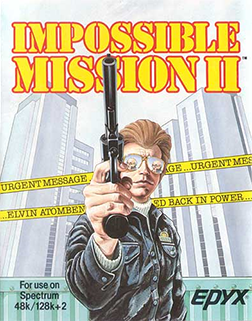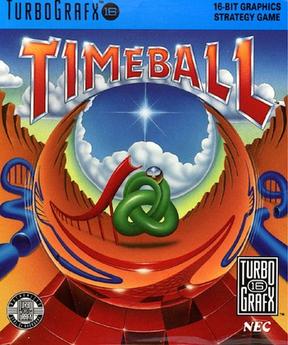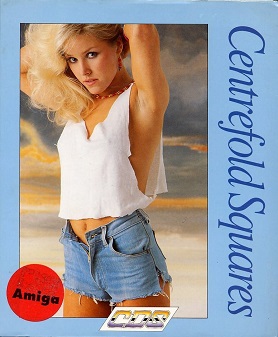
Spitting Image is a British satirical television puppet show, created by Peter Fluck, Roger Law and Martin Lambie-Nairn. First broadcast in 1984, the series was produced by 'Spitting Image Productions' for Central Independent Television over 18 series which aired on the ITV network. The series was nominated and won numerous awards, including ten BAFTA Television Awards, and two Emmy Awards in 1985 and 1986 in the Popular Arts Category. The series features puppet caricatures of contemporary celebrities and public figures, including British Prime Ministers Margaret Thatcher and John Major and the British royal family. The series was the first to caricature Queen Elizabeth The Queen Mother.

The Great Giana Sisters is a platform game developed by the West German company Time Warp and published by Rainbow Arts in 1987 for home computers such as the Commodore 64, Amiga and Atari ST. Players control Giana to explore a magical world inside their dreams; to wake up, they must find a giant diamond. They traverse side-scrolling stages while avoiding hazards such as monsters and other enemies. These can be defeated by using power-ups, which grant the player abilities such as firing projectiles and making enemies fall asleep.

Ataxx (アタックス) is a strategy video game published in arcades by Leland Corporation in 1990. Two players compete on a seven-by-seven square grid. The object of the game is for a player to have a majority of the pieces on the board at the end, by converting as many of their opponent's pieces as possible. In a single-player game, the opponents are "bio-invaders from a different dimension."

Loopz is a puzzle video game designed and programmed by Ian Upton for the Atari ST in 1989. He previously worked as head game designer for Audiogenic, who acquired exclusive rights to the game, then in 1990 arranged for Mindscape to publish it for computers in North America and consoles worldwide.

Impossible Mission is a video game written for the Commodore 64 by Dennis Caswell and published by Epyx in 1984. The game features a variety of gameplay mechanics from platform and adventure games, and includes digitized speech. Impossible Mission, which casts the player in the role of a secret agent infiltrating an enemy stronghold, is considered one of the best games for several platforms.

Tetrisphere is a puzzle video game developed by H2O Entertainment and published by Nintendo for the Nintendo 64. It was released in North America on August 11, 1997, and in PAL regions in February 1998. The game, originally titled Phear, was initially intended for release on the Atari Jaguar in early 1995 but was reworked into a Tetris game for the N64 after Nintendo, a licensee for The Tetris Company, obtained the publishing rights.

A sliding puzzle, sliding block puzzle, or sliding tile puzzle is a combination puzzle that challenges a player to slide pieces along certain routes to establish a certain end-configuration. The pieces to be moved may consist of simple shapes, or they may be imprinted with colours, patterns, sections of a larger picture, numbers, or letters.

Impossible Mission II is a video game developed by Novotrade and published by Epyx in 1988. It was released for the Commodore 64, ZX Spectrum, Amstrad CPC, Enterprise 128, Nintendo Entertainment System, MS-DOS, Atari ST, Apple II with at least 128K, Apple IIGS, and Amiga.

Hexic is a 2003 tile-matching puzzle video game developed by Carbonated Games for various platforms. In Hexic, the player tries to rotate hexagonal tiles to create certain patterns. The game is available on Windows, Xbox 360, Windows Phone and the web. Many clones are available for Android and iOS. The game was designed by Alexey Pajitnov, best known as the creator of Tetris. While most earlier releases of the game were developed by Carbonated Games, the most recent version released for Windows and Windows Phone is developed by Other Ocean. The name is a portmanteau of the words "hectic" and "hexagon".

Pipe Mania is a puzzle video game developed by The Assembly Line for the Amiga and published in 1989. It was ported to several other platforms by Lucasfilm Games as Pipe Dream; the company distributed the game in the US. The player must connect randomly appearing pieces of pipe on a grid to a given length within a limited time.

Sanxion is a horizontally scrolling shooter developed by Stavros Fasoulas for the Commodore 64 and published in 1986 by Thalamus Ltd. It was the first game released by Thalamus. A ZX Spectrum port followed in 1989. Fasoulas also wrote Delta and Quedex.

Loco-Motion, known as Guttang Gottong in Japan, is an arcade puzzle game developed by Konami in 1982 and released by Sega in Japan. The North American rights were licensed to Centuri. In Loco-Motion, the player builds a path for their unstoppable locomotive by moving tracks which will allow it to pick up passengers.

Pandora's Box is a 1999 video game created by Alexey Pajitnov for Microsoft.

Pixelus is a puzzle video game released for the Microsoft Windows and Mac OS X in 2005. A deluxe version was released later in the year. The story follows a young Greek man named Claudius who is shipwrecked and rebuilds temple mosaics in order to gain the favor of the gods. The gameplay of Pixelus is a clone of the Japanese 2001 game Guru Logi Champ published for the Game Boy Advance.

Welltris is a puzzle video game, developed by Doca and licensed to Bullet-Proof Software. It is an official game in the Tetris series. Adaptations were made by Sphere, Inc., for Spectrum HoloByte, and by Infogrames. It was released for MS-DOS compatible operating systems in 1989. Ports for Macintosh, Amiga, Amstrad CPC, and Atari ST followed in 1990, then ZX Spectrum and Commodore 64 in 1991.

Timeball is a puzzle video game released by NEC for the TurboGrafx-16. The object of the game is to guide a ball along pieces of track by moving tiles like a sliding puzzle. The game's name in Japan is Blodia, an anagram of Diablo, the title of a computer game upon which Blodia is based. Versions of Blodia were released exclusively in Japan for the original Game Boy and the Sharp X68000. A spin-off titled Blodia Land: Puzzle Quest was released for the Famicom, replacing the ball with cartoon dinosaur-like characters. These versions were developed by Tonkin House and published by Broderbund.

Tiger Road is a hack and slash platform game originally released in 1987 as a coin-operated arcade video game.

Spitting Image is one-on-one fighting game released in 1989 featuring characters from the Spitting Image puppet show. Developed by Walking Circles and published by Domark, it was available for the Commodore 64, ZX Spectrum, Amstrad CPC, and Amiga.

Friday the 13th: The Computer Game is the first game adaptation based on the films of the same name. It was released in 1986 by Domark for the Amstrad CPC, Commodore 64, and ZX Spectrum. The game was released on floppy diskette and cassette tape. The player's goal is to find and kill Jason, while making sure their friends or they themselves are not killed by Jason.

Centerfold Squares, retitled Centrefold Squares in Europe, is an erotic puzzle game originally developed and self-published by Artworx and released in 1988 for the Amiga, Atari ST and DOS. The game is a variation of Reversi where rectangular sections of an image of a nude model are revealed as the player earns points. Centrefold Squares was published by CDS Software in Europe, and published by Proein S.A under the original American title in Spain.



















